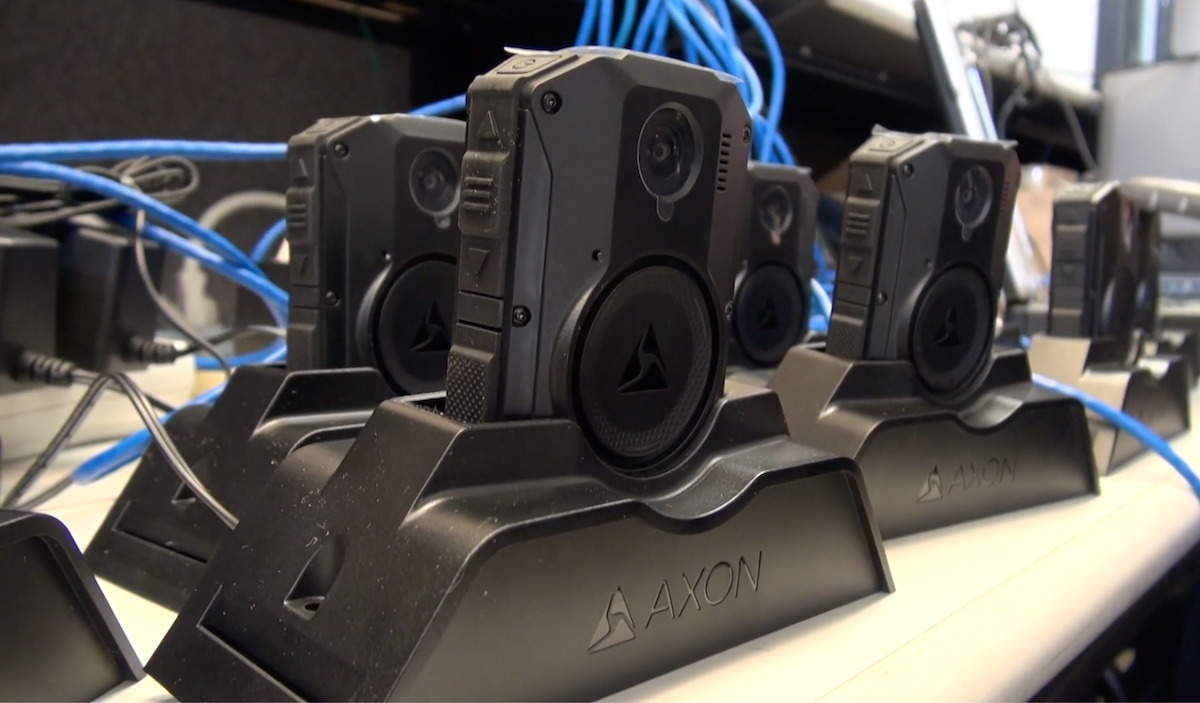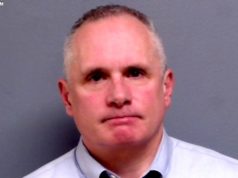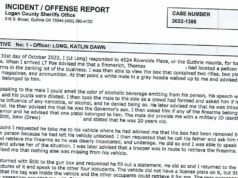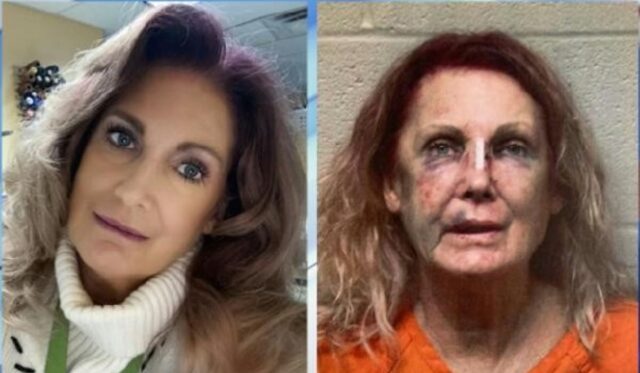
For more than seven minutes, the screams of a 68-year-old great-grandmother can be heard on the recording of an Oklahoma Highway Patrol trooper’s dashboard camera during a traffic stop arrest that left Nancy Kemp with a broken nose, seven broken ribs, a broken foot, emotional trauma and misdemeanor charges.
Much of what transpired, however, cannot be seen.
That’s because the trooper who pulled Kemp over about 12:30 a.m. May 11, 2022, was not wearing a body camera, increasingly common technology that records critical incidents involving law enforcement officers and the public.
The May 2022 use-of-force interaction mostly took place outside of Trooper Preston Cox’s cruiser after he had stopped Kemp for driving with her high beams on within one car length of another motorist on Interstate 35, just south of Guthrie.
Cox had asked Kemp to sit in the passenger seat of his cruiser for questioning, and when he suddenly put the car in reverse to make room for a field sobriety test, Kemp protested. She reached for her belongings in an attempt to exit the vehicle, and Cox grabbed her. As they struggled and argued, he followed her out of the passenger-side door and onto the ground.
While OHP’s microphone equipped to Cox’s uniform picked up the audio of the physical altercation, prosecutors and the public can only see video in front of the vehicle and inside its empty interior.
“Please don’t do that, please, please don’t!” Kemp can be heard screaming at Cox in the dash-cam audio. “Please stop, please. I’m begging you.”
Multiple times, Cox can be heard telling Kemp to put her hands behind her back.
“Get on the ground! Get on your face!” Cox yells.
“Oh my God, my nose … my nose. Please stop!” Kemp screams.
After several minutes, Cox handcuffs Kemp and radios for an ambulance, which took her to a local hospital before she was booked into the Logan County Jail. Cox stayed at the scene, reappearing on the dash cam out of breath but seemingly uninjured. In his incident report, Cox wrote that he delivered five blows to Kemp’s face, four times with his knee and once with his elbow.
Kemp was charged with misdemeanor counts of obstructing a police officer and resisting arrest, as well as two traffic violations. More than a year later — with delays caused by illness, a change in attorneys and her refusal to enter into a plea deal — Kemp’s case is pending in Logan County District Court. A hearing is set for Thursday, Aug. 10.
The Department of Public Safety’s internal investigation deemed Cox’s actions justified and determined he did not violate OHP policy, and Logan County District Attorney Laura Thomas agreed. Meanwhile, Kemp and her family question why such physical force was considered necessary. In addition to the bodily injuries, Kemp has sought therapy to help deal with emotional trauma.
More than a year later, the incident has highlighted how the state of Oklahoma’s largest law enforcement agency largely lacks the body-worn camera technology being adopted by departments across the country in an effort to document critical incidents for the sake of officers and the public alike.
‘Troopers are not required to wear body cams’
Oklahoma Highway Patrol troopers involved in enforcement actions are not required to wear body cameras on duty, unlike most large police departments and many county sheriff offices in the state.
The agency has a nearly eight-year-old chief’s directive that established an optional body camera program and guides troopers on the use of the devices:
- Body cameras may be assigned to individual members of the patrol at the discretion of the chief’s office or the chief’s designee;
- Members wishing to use a personally owned body camera while on duty shall request such use through their chain of command to the chief’s office.
The OHP’s policies and procedures apply to both department-issued and personally owned body-worn cameras.
Only about 40 of OHP’s 743 troopers, which include supervisors all the way up to the commissioner, are wearing body cameras, said Sarah Stewart, spokeswoman for the Oklahoma Department of Public Safety. Troopers’ cruisers are equipped with dash cams facing in front of the car and within the vehicle.
“He was not wearing a body cam during the incident,” Stewart said of Cox during his traffic stop of Kemp. “Troopers are not required to wear body cams.”
DPS legislative liaison Capt. Preston Lay said that, despite the agency’s ongoing requests for facility upgrades and technology investments, adding body cameras is not a priority for the Oklahoma Highway Patrol at this time.
“We currently equip every patrol vehicle with an in-car video recording equipment that’s similar to the dash cam, but it digitally records everything the trooper does, so we don’t currently have the intention to put body cams on each trooper that are out working because of that,” he said. “It would actually be a redundancy of what we’re trying to do to record our conversations in our traffic stops, so it’s less expense to just do that one way or the other, and since we’re primarily traffic enforcement, it’s appropriate to have that video equipment in the cars.”
The dash cams, however, only record video of activity that occurs inside or in front of the trooper’s vehicle. The actions of a motorist in their car are not recorded, nor are events to the left, right or rear of a trooper’s cruiser.
“We still have the audio recordings,” Lay said. “A trooper does wear a body mic that is interacting with the camera that’s in the car, so all of that will be recorded. But unfortunately, when they get away from the car, we don’t have the digital footage of the event.”
According to a statewide contract with the Office of Management and Enterprise Services, the Department of Public Safety’s WatchGuard dash cameras are purchased from the telecommunications company Motorola Solutions, which acquired WatchGuard in 2019.
In addition to the expense of purchasing body cameras and storing the video files, outfitting troopers with a body camera has proven to be unreliable in the past, Lay said.
“We’ve had some divisions that had both in-car and body cams, and what we found was that they malfunction so often that it was in need of repair on a regular basis, that they didn’t have them anyway because they were off getting repaired, and we get them back and then they malfunction again,” he said. “We don’t have the experience of the same mechanical failures with the in-car video cameras.”
The topic of OHP body cameras malfunctioning came up during the recent federal trial of former state Rep. Dan Kirby, who was convicted of involuntary manslaughter after testing positive for a variety of intoxicating substances following a motorcycle wreck that killed his girlfriend.
Prosecutors showed video evidence from a trooper’s vehicle dash cam of the field sobriety test conducted with Kirby. After Kirby was unable to follow the trooper’s instructions three separate times during one part of the test, Kirby opted to not continue. The trooper testified that, although he was wearing a body camera, it malfunctioned and he “has no idea why.” While the OHP trooper and Kirby were both visible in the dash cam footage, attorneys for the prosecution and the defense each attempted to dissect the field sobriety test by describing factors that were not clearly captured on the dash camera.
Lay said troopers assigned to Troop W, the Oklahoma Highway Patrol’s marine enforcement division, are equipped with body-worn cameras because most of their work is done on boats.
“Their interactions are out on water where in-car video cameras are not appropriate because they’re not made for boats,” Lay said.
Body cameras were discontinued for troopers in Troops S, the patrol’s commercial motor vehicle enforcement division, because the cameras often had to be repaired, he said. Often, the body-worn cameras would come into contact with parts of trucks being inspected, such as brakes, or suspension and frame components.
“They were always bumping those into parts of the truck, so they would crack the lenses and then either that or they would just quit working completely,” Lay said. “We would have to send them off to repairs, which is very expensive and time consuming, and then while that was taking place, we couldn’t afford to have spares on hand, so we just stopped using them.”
Trooper Kevin Crawford, president of the Oklahoma State Troopers Association, said body cameras were helpful when he used them when he was with Troop S. The body cameras were used mostly to show defects on the vehicles they were inspecting.
“We liked them when we had them,” he said. “In Troop S where, we were inspecting trucks [for] violations, we thought it was helpful. Most of us did.”
Crawford said he was told body cameras were decommissioned for Troop S because it was too expensive to pay storage fees for the video captured by the cameras.
“That was a major issue for the department,” he said.
Crawford said the Oklahoma State Troopers Association has not taken a position on the use of body cameras for troopers.
“We really don’t have a stand,” he said. “We’ll discuss any issue that the guys bring up. I haven’t heard anybody complain about not having them or having them. It hasn’t been a big deal, really.”
Use-of-force events and ‘reckless trooper actions’ scrutinized
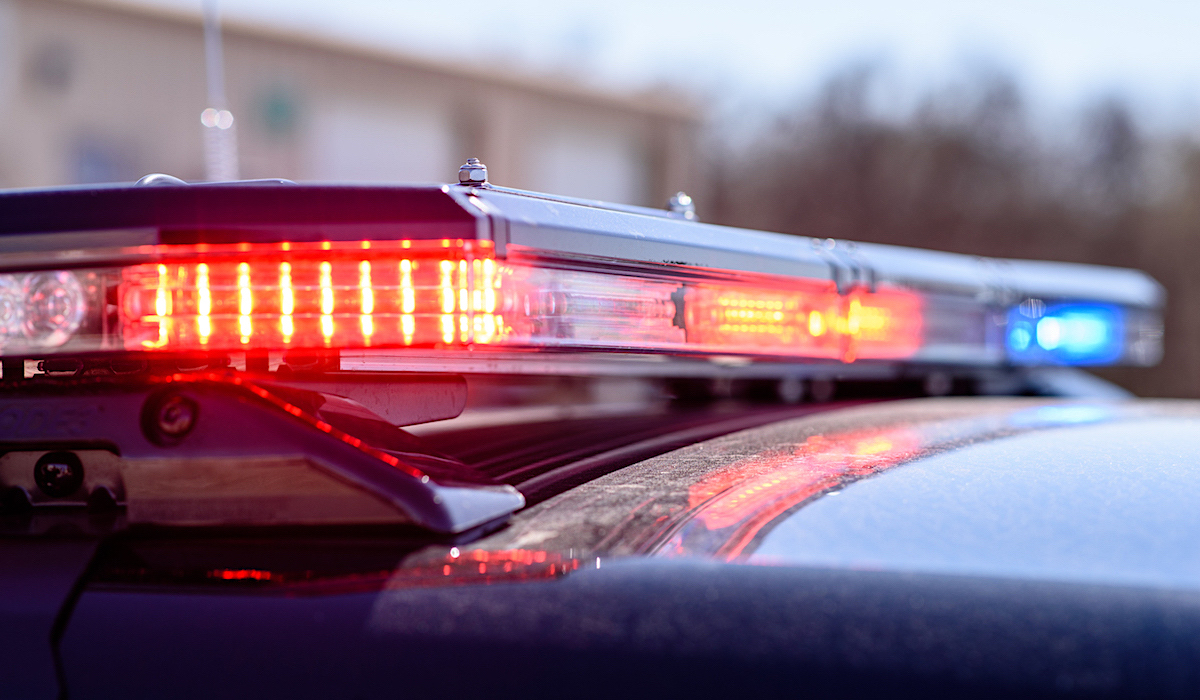
Troopers interact with the public through hundreds of traffic and motor vehicle inspection stops they make each week. Over the years, some incidents of Oklahoma troopers displaying inappropriate conduct with motorists have become public. In 2009, a trooper’s aggressive confrontation with Muscogee Nation paramedics made national news and resulted in a five-day suspension. In 2014, former Trooper Eric Roberts was accused of sexually assaulting three women during different traffic stops. He eventually pleaded guilty to some of the charges and was sentenced to eight years in prison.
More recently, Corey Jones of the Tulsa World has investigated Oklahoma Highway Patrol pursuits and shootings that end with fatalities. The review of cases “has uncovered reckless trooper actions, shoddy record-keeping, failure to address ‘alarming’ concerns expressed by commanders, and unwillingness to formally review several fatal chases despite red flags.”
Over a six-year span, 21 people have been killed in 17 Oklahoma Highway Patrol pursuits, 16 of which were prompted by traffic stops or property crimes, according to the Tulsa World. Of those killed, at least 10 were not the eluding driver.
The state’s top law enforcement officer, Attorney General Gentner Drummond, was unaware that Oklahoma troopers are not required to wear body cameras, a spokesman said.
“The attorney general believes those decisions are best left to the appropriate policymaking authority in the applicable jurisdiction,” said Phil Bacharach, communications director for the Attorney General’s Office.
Nancy Kemp’s attorney is Stephen Fabian, who worked 14 years until 1986 as general counsel for the Department of Public Safety. Had Cox been wearing a body camera, Fabian said it’s unclear what actions of Cox would have been recorded owing to the close nature of the use-of-force incident. Still, he praised the value of video technology in law enforcement.
“That was one of the best things that they ever did is put car cams in the automobiles, because it showed us as employees of the department what was going on, what this guy did, what the people did. It was wonderful stuff,” he said. “But it also showed us when somebody screwed up — when they were making stuff up.”
Body cameras intended to support trust, transparency
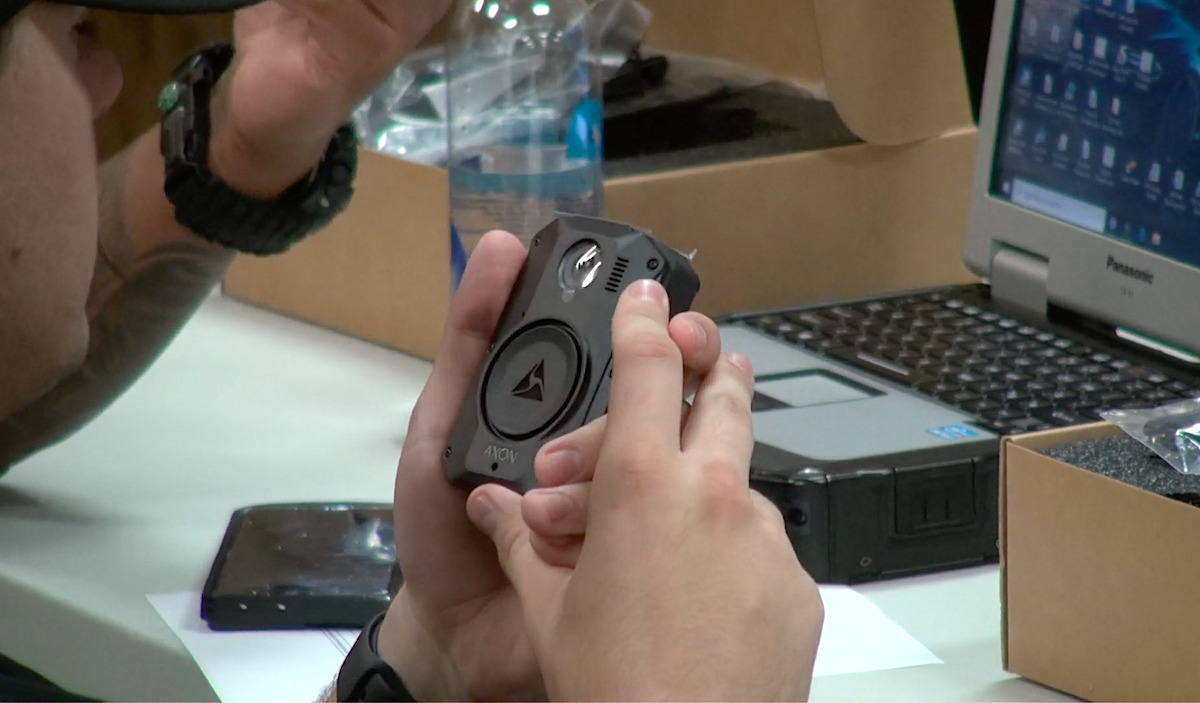
The Oklahoma City Police Department, Oklahoma County Sheriff’s Office, Tulsa Police Department and Tulsa County Sheriff’s Office each provide body cameras to officers and field deputies, as do the Norman Police Department and the Edmond Police Department. Broken Arrow police have also adopted the technology, as have a host of smaller law enforcement agencies in Oklahoma, including the University of Oklahoma’s police department.
RELATED
‘A long time coming’: More Oklahoma communities implementing police body cameras by Heide Brandes
“Body cams are an excellent tool for giving the public, detectives, police supervisors and prosecutors a more detailed look at an event,” OKCPD Master Sgt. Gary Knight said. “Body cams are unbiased. You actually get to see an incident unfold just as it happened, as opposed to just reading about it in a police report or hearing about it from a witness. In short, we love having them.”
Oklahoma City police officers, both on- and off-duty, are aware patrol officers are wearing body cameras. OKC police made national news in March when an off-duty supervisor was pulled over for suspected drunken driving and asked the arresting officer to turn off his body camera. The officer declined and captured the request on camera.
“Body cams have had a very positive impact on our department,” Knight said. “I imagine that body cams have, on occasion, improved the conduct of officers and citizens alike. Although body cams have sometimes caught officers behaving unprofessionally, they have also exonerated officers who’ve had false accusations made against them.”
Official policies within the OKCPD, the Oklahoma County Sheriff’s Office, the Tulsa Police Department and the Tulsa County Sheriff’s Office differ on some details, but in general the agencies’ leaders have said the technology increases community trust and provides additional records for use in adjudicating cases and training officers.
“Body-worn cameras will be used to maintain trust and transparency between the TCSO and the citizens we serve,” the body camera policy for the Tulsa County Sheriff’s Office states. “Body-worn cameras provide objective recordings of events that deputies encounter.”
Cox: ‘I struck Kemp in the face’ five times
In May 2022, Nancy Kemp’s initial attorney and KFOR-TV each requested the dash-cam footage of Kemp’s arrest. NonDoc requested the footage about seven months later on Dec. 9, and DPS ultimately released the video on Dec. 20. Kemp’s attorney said DPS’ delay in releasing the video showed a “lack of transparency,” while the agency blamed the delay on its own internal investigation.
In the dash-cam footage, certain statements made by Kemp and Cox — such as personally identifying information and a discussion about medication — are noted as having been redacted. But other segments of the video after Kemp’s arrest show Cox speaking with other law enforcement officers, yet some of his statements are not captured on audio even though traffic noise can be heard. Those moments are not designated as redacted by DPS.
Kemp was driving northbound on I-35 about 12:30 a.m. on May 11, 2022, when she was pulled over. In his probable cause affidavit, Cox said he stopped Kemp near I-35 and Seward Road because she was driving with her high beams on within one car length of another motorist.
Kemp said she was driving home from the 51st Street Speakeasy, an Oklahoma City bar and restaurant owned by her sons. She told Cox she had consumed one drink of tequila with a female friend.
In an interview with NonDoc, Kemp said she dimmed her lights as she passed the marked OHP cruiser, and then it came behind her and the trooper turned on his emergency lights. Dash cam video shows Kemp pulling over on the easement and stopping.
Kemp said she had never been stopped for a traffic violation before and was uneasy being in the situation alone in the middle of the night.
“I was scared of him,” she said.
On the dash cam video, Cox can be heard asking Kemp to sit with him in his cruiser. Kemp can be seen walking back to the cruiser holding something. In her interview, Kemp said it was her cellphone and that she had texted her daughter to say she had been stopped by a trooper on her way home. Cox asked her not to text anyone.
The dash cam inside the cruiser shows Kemp sitting in the passenger seat while Cox is filling out paperwork in the driver’s seat. A console separates them.
Everything seems rather calm, with Cox asking where she had been and whether she takes any medication. Cox says he has been to her sons’ bar and that inflation is making it difficult to run a business.
The mood becomes more tense when Kemp is seen using her phone.
“He was mad first off because I had texted my daughter that I had been stopped,” Kemp told NonDoc. “I was scared, it was dark, and I was by myself.”
Cox can be heard on the dash cam video saying, “I asked you not to do that.”
After appearing to complete paperwork, Cox puts the cruiser in reverse around eight minutes into the video.
“We’ll just back up, and I’m going to make sure you’re OK to drive real quick,” he says.
Around eight minutes into the video, Kemp seems to reach for her belongings and attempts to exit the vehicle.
“No, no!! she screams.
“Yeah, you are,” Cox shouts back, grabbing her arm, her head and her shirt.
Within seconds, they both exit the vehicle and fall to the ground.
“I did reach over to try to stop him from taking me there because I thought I was never going to be seen again,” Kemp told NonDoc. “That’s when he grabbed my head and slammed me into the dash, and I opened the door to try to escape him. He was yelling at me the whole time to give him my hand, and I’m yelling back at him, ‘You have my hand!'”
In his probable cause affidavit, Cox said he noticed Kemp had “red watery bloodshot eyes and slurred speech.” He said he completed a check on her through the Oklahoma Law Enforcement Telecommunications System and then put his cruiser in reverse “to create a gap between Kemp’s car and my patrol unit to conduct a standardized field sobriety test.”
“After placing my patrol unit in reverse, I told Kemp I had completed the license check and needed to make sure she was safe to operate a motor vehicle before leaving,” Cox wrote. “Kemp aggressively opened my door and slammed her left hand on my computer in (an) attempt to take her license before fleeing from my patrol unit.”
Cox wrote that he got on Kemp’s back and attempted to player her left hand behind her.
“I ordered Kemp multiple times to place her hands behind her back and she refused. Kemp continued to resist me by trying to keep her hands under her body,” he wrote. “In order to gain compliance, I struck Kemp in the face two times with my right knee. I continued to order Kemp to give her hands and Kemp continued to actively resist by not placing her hands behind her back. I struck Kemp in the face with my right elbow one time. I was able to gain compliance and place handcuffs on Kemp. While attempting to radio into OHP Troop A dispatch, Kemp slipped her handcuffs and was able to remove them from one of her wrists.”
Cox wrote that he gained control of Kemp and placed her in a back mount for a second time. He said Kemp continued to resist and seemed to be grabbing something beneath her.
“I successfully prevented Kemp from grabbing the object by striking her an additional two times with my right knee in the face,” Cox wrote. “I gained compliance and successfully placed the handcuffs on Kemp’s wrists for a second time.”
Cox wrote that he radioed for backup and also requested an ambulance for Kemp “due to her having blood on her face.”
During the struggle, Kemp can be heard screaming and pleading for Cox to stop.
“What did I do to you?” she yells. “What? Why?”
Kemp told NonDoc she was attempting to grab her phone from the ground during the incident.
“I was on the ground,” she said. “He was still beating me. I saw my phone. I slipped my hand out to grab it and he threw it. He said to put my hand back under me. He put me in restraint and then he got off of me.
Kemp said she is about 5 feet, 6 inches tall and weighs about 140 pounds.
“Any one of those blows could have killed me,” she said. “I felt anger in every blow.”
Logan County deputies and other state troopers arrive at the scene minutes after Cox radios for assistance.
“You OK?” a responder can be heard asking Cox.
“Yeah,” Cox replies.
Asked what happened, Cox says, “She tried to get the fuck out of the car.”
To Kemp, Cox can be heard saying, “You’re going to jail.”
She replies, “That’s fine.”
Deputies took her to a local hospital where she was treated. She was booked into the Logan County Jail about 3 a.m. and was released on bond about 7 p.m.
Criminal case continues in Logan County

Kemp was charged June 27, 2022, with four misdemeanor counts:
- improper use of multiple-beam rod-lighting equipment;
- operating a motor vehicle while under the influence of alcohol, or in the alternative operating a motor vehicle while under the influence of a combination of alcohol and an intoxicating substance;
- obstructing a police officer;
- and resisting arrest.
Logan County District Attorney Laura Austin Thomas issued a press release after filing the charges, saying Kemp was driving with her high-beam lights on less than 600 feet from a vehicle in front of her and that her blood-alcohol content registered at 0.093, above Oklahoma’s legal blood alcohol concentration limit of 0.08.
Thomas said it is a policy of the Oklahoma Highway Patrol as well as many other police agencies that detainees cannot use their phones during a law enforcement interaction.
“This is for the safety of the officer,” she said in the release. “Officers have been injured when hostile, impaired individuals call their ‘backups’ to the scene, posing additional threats to the officer.”
A responsible officer, Thomas wrote, cannot allow a person they believe to be drunk to just leave or flee the scene, regardless of age or gender.
“A 68-year-old woman, screaming, yelling, being totally noncooperative, attempting to escape and run, fighting with the officer and refusing to comply with lawful demands is no less a threat to the officer than a 32-year-old man or 19-year-old woman,” Thomas wrote. “Each could be in possession of a gun or other weapon. Each could harm the officer, themselves, or an innocent citizen.”
Thomas said she undertook “a nonemotional, legal analysis” of Kemp’s arrest before filing charges.
“This consideration resulted in a determination that the actions on the part of the arresting officer were a reasonable exercise of his duty to bring into compliance and control a drunk driver who was putting the general public, herself and the officer at risk of harm,” she said.
Thomas told NonDoc that she watched and listened to Cox’s dash-cam video as part of her decision-making.
“It’s still an ongoing case, and there’s been no plea,” Thomas said. “We filed what was the appropriate charges to file given the evidence we had, so we’re happy with our charges.”
Stewart, the DPS spokeswoman, said OHP looked into Cox’s actions during the traffic stop and determined he did not violate departmental policy.
“An OHP chief’s inquiry was also conducted into the use of force in the incident, and it was determined the trooper did not violate departmental policy and his actions were justified,” Stewart said. “The case has been closed with no further action.”
Any internal personnel investigation that might have been done is not subject to Oklahoma’s Open Records Act pursuant to Title 51, Section 24A.7, Stewart said.
“Trooper Cox’s duties have not changed,” she said.
Kemp said she is not interested in pleading guilty to any of the charges. Prosecutors, she said, have offered a deal for her to plead guilty to DUI in exchange for a two-year deferred sentence, 40 hours of community service and $930 in fines and court costs. Her next court appearance is scheduled for Thursday, Aug. 10.
She said her case has dragged on for the past year in part because her original lawyer was a friend who is not a criminal defense attorney. That attorney also contracted COVID and was unavailable for some time, Kemp said.
In March, Kemp hired Fabian, who specializes in DUI cases and whose website says he is recognized by his peers as one of the state’s most knowledgeable DUI defense attorneys. A former police officer, he has been a practicing attorney since 1973. He was general counsel and legal adviser for both the Department of Public Safety and the Oklahoma Highway Patrol. During his 14-year tenure, he prepared and set up the first statewide DUI Task Force, taught breathalyzer schools and led various law enforcement classes.
Fabian has filed motions compelling the state to produce the personnel files of Cox as well as a number of records and reports associated with Kemp’s arrest.
“We’re just trying to investigate,” he said. “Discover what we can discover.”
Kemp said the trauma from the incident prevented her from driving for more than a year. With the help of a therapist, she said she began driving again about two weeks ago.
There have been some good moments for Kemp, who has five great-grandchildren. In March, her 15th grandchild was born.
But the memory of last year’s traffic stop and the altercation with Cox continue to haunt her.
“I just want my life back,” Kemp said, “and I want him not to be able to do this to anybody ever again.”









